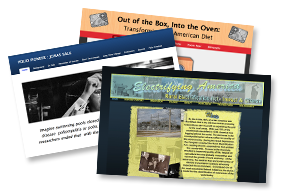Community Embraces New Word Game at Mid-Year Play Day This past Sunday, families at Takoma Park’s Seventh Annual Mid-Year Play Day had the opportunity to experience OtherWordly for the first time. Our educational language game drew curious children and parents to our table throughout the afternoon. Words in Space Several children gathered around our iPads […]
Read more This weekend, I was a judge at a local chapter of National History Day (NHD). I judged web sites. Amazingly, these sites were much better than those of many small history museums. The students’ sites used a mixture of text, images, video and audio clips in a thoughtful way. This year’s theme was “Debate and Diplomacy.”
This weekend, I was a judge at a local chapter of National History Day (NHD). I judged web sites. Amazingly, these sites were much better than those of many small history museums. The students’ sites used a mixture of text, images, video and audio clips in a thoughtful way. This year’s theme was “Debate and Diplomacy.”
I can’t show you the sites I reviewed, but here are 3 winning examples from 2010: Electrifying America; Polio Pioneer; and Out of the Box, Into the Oven.
The context for the student web sites was National History Day. This is a yearlong educational program that guides students to learn about interesting issues, ideas, people, and events of their choosing — and to express it via a creative and original performance, documentary, paper, web site, or exhibit. Teams of 2-3 students followed guidelines to create “a collection of web pages, interconnected with hyperlinks, that presents primary and secondary sources, interactive multimedia, and historical analysis… an accumulation of research and argument that incorporates textual and non-textual (photographs, maps, music, etc.) description, interpretation, and multimedia sources to engage and inform viewers about your chosen historical topic.”
Meanwhile, in the museum world, virtual exhibits are created by curators and education/outreach staff, and loosely fall into two types:
- Story-driven exhibits — In the virtual analogue to a physical museum, visitors are drawn through a story, guided through sections and subsections, filled with text and multimedia. These can be costly to produce if they have a lot of pages or extensive multimedia, but are inexpensive on the simpler end (as the student exhibits show). A decade ago, there was a boom in richly multimedia virtual exhibits as museums and publishers rushed to make virtual exhibits. That boom quickly tapered off, as sky-high develop costs did not lead to revenue, and virtual exhibits are now produced less often. The virtual exhibits at WebExhibits are mostly story-driven.
- Object-driven exhibits — Another approach is to focus on objects. Collection management software can stitch together objects and captions, giving visitors a web pages to browse. The premise is that if software is fed enough data, browsing objects online can approximate the experience of wandering the archives of a museum. Previously limited to deep-pocketed museum who could afford in-house software developments or commercial licenses, open source software like Omeka and CollectiveAccess now allow museums and archives to put collections online less expensively. Even WordPress can be used to navigate a collection (each post is an object or topic.) On a smaller scale, museums can accomplish a similar, limited goal using photo sharing sites like Picasa or Flickr photos, or even sharing photos within Facebook. A great example of using a blog/Facebook format is “Letters of Note.”
Students have been making web sites for National History Day and other annual contests like ThinkQuest since 1996. Kids do this in their after school time. Student projects avoid adult intervention, and so they suffer from typos, misdirected emphasis, awkward layouts, and limited research. But these flaws could all be easily remedied in a non-contest setting, if students were supervised by a historian or curator, and perhaps a design mentor.
If cheap, imperfect exhibits can be made by kids, there has to be a lesson for the establishment. But what’s the lesson? Should museums have summer internships with teams of kids? Should they partner with existing youth outreach projects? Or should they make more short & sweet virtual exhibits, which will not get bogged down with complex contracts, tedious planning and budget creep?
If museums don’t increase their investment in virtual exhibits, there is evidence that others will step up to the plate. Software companies are moving into this space. For example, see our recent post about “The virtual vs. the real: Giga-resolution in Google Art Project” where Google collected deliciously high-resolution photos, metadata, and interesting captions, to create a new kind of online art exhibit. And in the sciences, our blog post “Making of science apps: Not the usual suspects” talks about how eBook publisher TouchPress has created two interactive eBooks, on the periodic table and about the solar system, which are effectively hand-held virtual exhibits.

